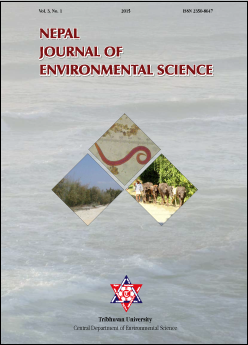Contribution of buffer zone and community forest programme in household income at Laharepauwa of Rasuwa and Tupche of Nuwakot, Nepal
DOI:
https://doi.org/10.3126/njes.v3i0.22729Keywords:
Buffer zone, Commnity forest, Household income, Opportunity CostAbstract
Historically, Nepal government has been adequately innovative to experiment new conservation and forestry models. The most marked policy shift was the Buffer Zone Management Regulation (1996) which provisioned for buffer zones and 30-50% revenue sharing with local institutions. Similarly, community forestry, which evolved in mid-70s’ has been innovative approach benefiting millions of forest users. The present study attempted to compare buffer zone and community forestry programmes in terms of economic benefits they bring to the local households. Altogether, 274 households were interviewed. Consultation meeting was organized with Langtang National Park office and District Forest Office, Nuwakot. Similarly, key informant interview was carried out with forest guards and key representatives of user’s groups. The most prevalent sources of incomes were agriculture and livestock. The result shows 92.4% households collected forest resources and derived a seasonal income from NTFP in Laharepauwa. The total and mean (HH/year) incomes calculated were respectively US$ 202,209 and US$ 1,395 for Laharepauwa and; US$ 304,316 and US$ 2,359 for Tupche. However, a share of buffer zone and community forest programme are only 4% and 7% respectively. Buffer Zone program saved 2,351 working days annually or opportunity cost worth US$ 11,198. Likewise, Community Forestry programme saved forest collection times worth US$ 16,586.4. The study concludes that direct benefits of these programmes are not significant but indirect benefit by saving resources collection time is substantial. It is imperative to interpret result cautiously as poverty is multidimensional phenomenon and current study didn’t consider the capabilities of communities to cope poverty.
Downloads
Downloads
Published
How to Cite
Issue
Section
License
This license enables reusers to distribute, remix, adapt, and build upon the material in any medium or format for noncommercial purposes only, and only so long as attribution is given to the creator.

